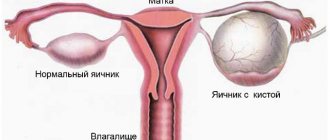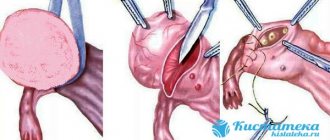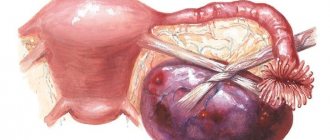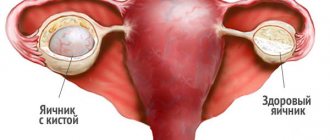Removing an ovarian cyst is a question that a woman has faced more than once in her life. Unfortunately, this pathology is common in women of childbearing age, and in postmenopausal women it requires special attention and quick treatment tactics.
Of all cysts, a larger percentage falls on benign ovarian tumors. It is important to remember that many formations have a risk of malignancy - malignancy, therefore clinical observation is very important for the purpose of early detection of the disease.
Types of cysts
The classification of cysts is primarily based on the structure and origin of a particular tumor. This classification is quite complex and is mostly used by histologists after conducting a specific study.
It is customary to distinguish a separate group of formations - functional cysts, which arise in the event of dysregulation of the menstrual cycle.
The most common cysts in gynecological practice are follicular, corpus luteum, endometrioid and teratoma cysts.
Removal during pregnancy
If a cystic formation is detected in a pregnant woman, the attending physician will initially prescribe regular ultrasounds to monitor the dynamics of tumor development. Additionally, light drug treatment can be selected that will not be dangerous for the patient and the fetus.
If drug treatment is ineffective and the pregnant woman’s condition worsens, surgery is prescribed, which is most often performed laparoscopically. Laparotomy is prescribed for very large tumors and in the most extreme cases, since this technique is dangerous for both mother and baby.
Causes
Among the most common causes of ovarian cysts are dysregulation of the menstrual cycle, lack of normal ovulation, and disruption of follicle maturation processes.
Endometrioid cysts are an external form of endometriosis, a systemic hormone-dependent disease. The appearance of teratomas is based on disturbances at the stages of embryogenesis; these types of tumors are always congenital and can occur in both ovaries.
Extragenital causes include dysfunction of the thyroid gland, obesity, prolonged stress and emotional stress, poor lifestyle, and frequent abortions.
There are no clearly defined causes of cysts. Often a combination of several factors play a role.
The most common cyst
This type occurs in women of reproductive age and is called functional. This formation is a violation of the process of release of an unfertilized egg. That is, the follicle from which the cell should come out during menstruation does not rupture and begins to fill with liquid. Such a formation usually resolves on its own by the next cycle and only in rare cases grows to several centimeters.
The operation requires a size of about 8 cm, but most often the problem is eliminated with medications. Manifestations of such a cyst are nagging painful sensations in the lower abdomen. If you do not consult a doctor in time, you can get complications in the form of rupture of the bladder or torsion of its stem.
Diagnostics
If the size is significant, the doctor can detect the formation during a routine bimanual examination on the gynecological chair; if the cyst reaches gigantic proportions, then it can even be felt through the anterior wall of the abdomen.
Smaller tumors are best diagnosed with routine ultrasound. This method allows you to evaluate the exact size, structure and expected nature of the formation.
The doctor also conducts a Doppler examination of the vessels feeding the cyst. Additional instrumental methods are computed magnetic resonance imaging.
These studies may be prescribed if the location is atypical or difficult to visualize on ultrasound.
From laboratory tests, it is necessary to determine the tumor markers CA-125 and HE4. They help indirectly assess the benign nature of the tumor.
How long does the operation take?
Many patients who decide to remove a cystic formation through surgery are concerned with the question, how long does the operation last? But as practice shows, the operation time varies greatly depending on the chosen technique, the presence of complications and the general condition of the patient. If laparoscopy is performed, its duration can range from 30 minutes to one and a half hours, while the duration of laparotomy, depending on the situation, can be more than 2 hours. It all depends on what actions the surgeon will need to perform.
The least amount of time is needed to simply remove the cystic capsule, but if the affected ovarian tissue must be excised or the entire organ removed, this requires much more time.
When is surgery to remove a cyst necessary?
Ordinary functional cysts do not need to be operated on. As a rule, they go away on their own after the next menstruation starts.
The doctor can prescribe a course of gestagens or combined oral contraceptives for up to 3-6 months, which almost always lead to a cure for the patient.
If there is no effect from hormonal therapy, we have to talk about the non-functional nature of the formation and change tactics from conservative to surgical.
Endometrioid cysts should be removed if they are large in size and/or affect the overall hormonal levels and disrupt the onset of ovulation. Such tumors often underlie endocrine infertility.
Teratomas and cysts that cannot be treated with medication, they must be removed surgically, because they have a very high risk of malignancy.
You should definitely know about this when planning a pregnancy, during which a hormonal surge occurs. Such conditions can cause unpredictable and uncontrolled growth of the formation.
Women planning in vitro fertilization (IVF) are required to undergo surgery before entering into the protocol.
So, in what cases should you operate immediately?
Emergency surgical treatment is carried out in case of severe, persistent pain in the lower abdomen with irradiation to the rectum, or disturbances in the general condition (drop in blood pressure, nausea, vomiting).
These symptoms indicate serious complications of cysts - torsion or rupture of the capsule with bleeding into the pelvic cavity. These complications pose a significant danger to a woman’s life.
The slightest sign indicating a complication of the structure of the formation, rapid growth of the tumor, severe compression of neighboring organs is also an indication for urgent removal of the cyst.
Multi-chamber cyst
This formation can be treated with a conservative method only up to 5 cm. It includes hormonal therapy, taking vitamins, anti-inflammatory and antitumor drugs. If the condition is advanced, surgery will be required. Cystadenoma is filled with serous fluid and can consist of several or one compartment, and if large, it leads to an increase in part of the abdomen. This formation very rarely develops into malignant, but cases have still been recorded.
Preparation for surgical treatment
Of course, if indications for emergency surgery arise, there is no need to talk about preparation. If you are scheduled for a planned operation, the doctor will prescribe a list of mandatory tests and procedures.
These include determination of blood group and Rh factor, biochemical and clinical analysis of blood and urine, coagulation test, markers of HIV, hepatitis B and C, and syphilis.
Often, to perform a laparoscopic method of removing a tumor, it is necessary to undergo gastroscopy and colonoscopy.
The therapist will look at fluorography of the lungs, ECG and assess the risks of complications from the cardiovascular system.
You must be prepared for the fact that if changes in laboratory tests are detected, consultation with related specialists may be required.
Cost of surgery
It is very difficult to say exactly how much surgery to remove a cystic formation will cost, since the cost of the operation will depend on many factors. The price for removal is determined by the category of medical institution and specific specialist, the severity of the pathology, the number of manipulations performed and the method of surgical intervention. Additionally, you need to take into account that before surgery is performed on a cyst, you need to spend money on diagnostics and preliminary tests, and you also need to bear the costs of rehabilitation after surgery.
The average cost of removing cystic tumors using the laparoscopic method is 15-40 thousand rubles. Laparotomy will cost more – from 30 thousand rubles. When choosing a clinic for such operations, you should pay attention not so much to the cost of the operation, but to the qualifications of the medical staff.
Types of surgical treatment
There are two main methods for removing ovarian cysts: laparotomy and laparoscopic.
1) Laparotomy is an abdominal operation with a layer-by-layer incision of soft tissues and the same layer-by-layer suturing after the end of the intervention.
This type is used in case of emergency, bleeding into the abdominal cavity. Laparotomy allows you to quickly get to the ovaries, remove the problematic formation and carry out thorough hemostasis.
At the end of the operation, the surgeon places a special tube - drainage for the outflow of pathological fluid. Drainage also allows you to administer medications to the surgical area and wash it if necessary.
Laparotomy access is also used for very large tumors, when a wide surgical field is needed, in complex clinical cases.
2) Laparoscopy is considered a more gentle and, undoubtedly, advanced method. During this method, penetration into the pelvic cavity occurs through small incisions in the navel and ilium. The length of these incisions rarely exceeds 10 mm and averages about 5-7 mm. A puncture of the abdominal wall is carried out with a trocar, through which gas is pumped into the cavity and a telescope with a camera and a light source are connected.
The camera displays a clear image of the internal organs on a large screen. The surgeon's assistant rotates the camera so as to completely show the operating doctor the area of damage and controls the location of the operating area in the center of the screen.
Instruments for surgery, called manipulators, are inserted through incisions in the lower abdomen.
Laparoscopy is part of minimally invasive surgery, has a very low complication rate and does not require long recovery.
This method of intervention can also be used for diagnostic purposes, when it is necessary to determine further tactics and the need for more radical measures.
Of course, this method also has its drawbacks. Insertion of instruments requires some time, and large formations are difficult to remove through narrow manipulator guides. Massive bleeding during surgery greatly limits the surgeon's capabilities.
If before the operation there was the slightest suspicion that the tumor was of a substandard nature, during the intervention itself an emergency histological examination is carried out, the results of which determine the further course of the operation, the need to invite additional specialists, and the area of removal of ovarian tissue.
Be that as it may, any material obtained during the operation is sent to the laboratory for a thorough study of its nature of origin. The result of this study determines further conservative tactics and often determines the chances of pregnancy.
Laser removal
Methods similar to laparoscopic ones include laser removal of ovarian cysts. This method is used for small formations.
First, local anesthesia of the skin is performed, and then a special thin instrument is inserted. The advantage of this technique is that the laser emanating from the instrument has a good hemostatic effect.
Laser removal is a fairly promising area in minor surgery that does not require general anesthesia.
Treatment methods for ovarian cysts
Conservative treatment of cysts
is most often carried out during menopause in women, when the patient no longer plans to become pregnant. The same tactics are used for newly identified cysts of small diameter (up to 10 centimeters). If an ovarian cyst is detected, treatment consists of a wait-and-see approach for 3 months, taking into account the fact that most formations in the ovaries are capable of undergoing reverse development (self-resorption) over several menstrual cycles. In this case, dynamic monitoring should be performed using ultrasound to monitor the size of the formation. If there is no positive dynamics, anti-inflammatory and hormonal therapy is carried out.
Treatment of ovarian cysts with hormonal drugs (progesterone or its analogues) is aimed at reducing the level of estrogen in the patient’s body and creating conditions to prevent ovulation. This allows you to start processes that will contribute to the reverse development of the cyst and prevent the formation of a new cyst. Hormonal therapy can also be supplemented by taking vitamins (folic and ascorbic acid and vitamin E) and restorative drugs. Stimulating the immune system can provoke protective reactions that will be aimed at preventing the development of the disease. If a positive effect is not observed during hormonal therapy, or the cysts increase in size, then surgical treatment is indicated.
Surgery to remove an ovarian cyst
The approach to choosing the volume of surgical intervention and access to the surgical site is purely individual. The decision is made based on the results of the examination and discussed with the patient before surgery, however, adjustments are possible during surgery.
Indications for surgery:
- Any formation that exists in the ovary for more than 3 months and has not disappeared without treatment or with hormonal therapy.
- Formations in the ovaries discovered during menopause.
- Complications of the cyst: suppuration, hemorrhage, rupture, and torsion of the leg.
- Malignant process.
Relative contraindications to surgical treatment:
- diseases associated with poor blood clotting;
- cardiovascular and neurological diseases in the acute stage;
- genitourinary system infections;
- internal bleeding;
- advanced stages of obesity;
- lung damage;
- problems with constant bloating;
- fistulas
Pregnancy after removal
When a cyst is discovered in patients of reproductive age and its removal is scheduled, the first thing they are interested in is whether it is possible to get pregnant after surgery? The possibility of conception will depend on how deeply the tissue is affected and what part of the reproductive organs will have to be removed during the intervention. According to statistics, pregnancy after removal of an ovarian cyst occurs in two thirds of operated women. If the operation was carried out without removing the gonads, then ovulation will normalize, and after a maximum of six months, but not earlier than three months, you can plan a pregnancy. Conception is also possible if one of the ovaries is removed, because ovulation will also be restored over time; if the reproductive cell is not fertilized naturally, the woman can resort to IVF.
To increase the chances of successful conception after removal of a cystic formation, it is imperative to follow all doctor’s appointments and instructions in the postoperative period.
Clinical signs of cysts and complications
Gap
The cyst may go away on its own, but when it does not go away, it begins to grow, the pressure in it increases, and the cyst may rupture. This condition is dangerous; it can result in peritonitis - inflammation of the peritoneum.
If the formation is large and has a stalk, then the latter may twist. At the same time, the veins are compressed, and blood flow in the cyst is disrupted. Torsion of the legs is dangerous due to necrosis - tissue death. This complication is more common with dermoid and luteal cysts.
Cyst inflammation
The inflammatory process can affect any type of cyst. The reasons are genital infections, manipulation of the genitals (curettage), and the IUD not being removed in time. Untreated infection leads to infertility.
Organic cysts - dermoid, serous, endometrioid, etc. - can degenerate into a malignant formation. Functional formations: follicular, luteal cysts do not degenerate into cancer.
Infertility
Another serious consequence facing an ovarian cyst. It is caused by inflammation, the occurrence of adhesions on the fallopian tubes and ovaries.
Dangerous signs of complications:
- uterine bleeding, spotting in the middle of the cycle;
- severe cutting pain in the lower abdomen;
- a sharp deterioration in health, including nausea, sometimes vomiting;
- severe weakness and dizziness.
With these signs, immediate help is required, as complications of the cyst are deadly.
After surgery to remove an ovarian cyst, in rare cases complications arise due to individual intolerance to medications (antibiotics, narcotics).
Possible consequences may include infection of wounds, bleeding, and the formation of blood clots in blood vessels. A specific, extremely rare complication is accidental damage to the ovaries, fallopian tubes, bladder or intestines during cyst removal.
It is possible that adhesions may form around the ovaries, which subsequently cause infertility. This pathology occurs in approximately 15% of operated women. There is a possibility of recurrence of cysts after cystectomy.
Warning: The more complex the operation, the higher the likelihood of complications. Therefore, it is so important to undergo regular gynecological checks of the condition of the genital organs, during which neoplasms can be detected at the initial stage of their development.
Hormonal restoration occurs within 4-6 months. During the rehabilitation period, a woman may be in a state of depression and feel hot flashes, as during menopause. After using anesthesia, problems such as rapid heartbeat, increased blood pressure, headaches, and insomnia appear.
You should consult a doctor as soon as possible if, after removal of an ovarian cyst, redness of the suture and sanguineous discharge from the wound are observed.
The restoration of menstruation should occur in 1-3 months. If they linger, become scanty, spotting or purulent discharge from the genitals appears, this indicates the occurrence of diseases of the appendages. If bleeding or pain in the abdominal cavity occurs during the postoperative period, you should consult a doctor immediately.
During the recovery period after surgery, a woman should not lift anything heavy or perform sports exercises that involve bending over or tensing the abdominals. It is necessary to regulate the functioning of the digestive system to avoid constipation or intestinal upset.
Thermal procedures should be avoided. Sexual relations can be resumed after 1 month, but pregnancy can be planned no earlier than 3 months after the operation.
In terms of its symptoms, the course of the disease manifests itself differently, depending on the stage of the pathological process. If hormonal parameters do not deviate from the norm and the cystic formation grows slightly, then no pronounced symptoms are observed. The progression of the disease leads to:
- to the appearance of aching painful sensations in the lower abdomen, which are more intense on the right, if it is an endometrioid cyst of the right ovary, and on the left, if the left ovary is affected;
- to pain along the entire line of the lower abdomen with bilateral development of the process;
- to heavy blood loss during menstruation and spotting during the intermenstrual period;
- to general weakness, malaise, mild nausea;
- to frequent urination;
- to unsuccessful attempts to get pregnant.
Untimely treatment of the pathology provokes secondary complications:
- problems with the maturation of eggs in the ovaries that have undergone structural changes due to the functional activity of the endometrioid cyst;
- compression and deformation of the ovarian body due to a growing tumor;
- inflammation and development of suppuration at the location of the cyst;
- scarring of the ovarian region of the ovaries due to the proliferation of cystic structures;
- the appearance of adhesions in closely located tissues of neighboring pelvic organs.
All these abnormal processes lead to disruption of a woman’s reproductive functions and interfere with the normal process of conception, which results in infertility.
But the most dangerous condition can develop when the cystic capsule ruptures, when its bloody contents leak into the abdominal cavity. The woman feels a paroxysmal acute pain in the abdomen, a sharp drop in pressure is recorded, the body temperature rises significantly, and the condition is close to fainting. In this case, emergency medical care in a hospital through surgical intervention is indicated.
Any operation has its own risks and complications. Despite the more gentle technique, during laparoscopy injuries to neighboring organs are possible; the trocar is inserted into the abdominal area blindly and there is always a minimal risk of injury to large blood vessels.
Laparotomy has an order of magnitude greater number of complications. In addition to those mentioned above, there are risks of unsuccessful hemostasis and the occurrence of postoperative bleeding and adhesions.










